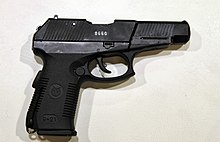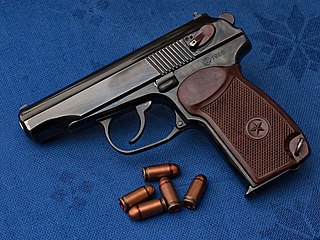
The Makarov pistol or PM is a Soviet semi-automatic pistol. Under the project leadership of Nikolay Fyodorovich Makarov, it became the Soviet Union's standard military and Militsiya side arm in 1951.

The Walther P99 is a semi-automatic pistol developed by the German company Carl Walther GmbH Sportwaffen of Ulm for law enforcement, security forces and the civilian shooting market as a replacement for the Walther P5 and the P88. The P99 and its variants are also made under licence by Fabryka Broni Radom.
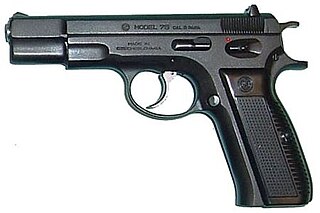
The CZ 75 is a semi-automatic pistol made by Czech firearm manufacturer ČZUB. First introduced in 1975, it is one of the original "wonder nines" and features a staggered-column magazine, all-steel construction, and a hammer forged barrel. It is widely distributed throughout the world and is the most common handgun in the Czech Republic.

The SIG Sauer P220 is a semi-automatic pistol designed in 1975 by the SIG Arms AG division of Schweizerische Industrie Gesellschaft, and produced by J. P. Sauer & Sohn, in Eckernförde. It is currently manufactured by both SIG Sauer companies: SIG Sauer GMBH, of Eckernförde, Germany; and SIG Sauer, Inc., of New Hampshire, United States.
The Daewoo Precision Industries K5 or K5/DP51 series is a 9×19mm semi-automatic pistol produced by SNT Motiv of South Korea.

The Margolin or Practice Shooting Pistol is a .22 LR pistol, primarily used for competitive target shooting in 25m Standard Pistol class under the rules of the International Shooting Sport Federation for bullseye round-target shooting at 25 m. The Margolin has been used since the 1950s, and complies with all international competition standards.

The Beretta 8000 (Cougar) is a family of rotating barrel semi-automatic pistols that were designed and manufactured by Beretta of Italy.

The OTS-02 Kiparis is a Russian submachine gun first designed by the TsKIB SOO design bureau of Tula in the early 1970s, although it was not introduced into service until 1991. It is primarily intended for internal security and police units, it was adopted by the Russian police and Ministry of Internal Affairs.

The MP-443Grach or "PYa", for "Pistolet Yarygina", following traditional Russian naming procedure, is currently the Russian standard military-issue side arm.

The Ruger SR-Series is a line of semi-automatic pistols manufactured by Sturm, Ruger & Company. At 1.18 in (30.0 mm) thick through the grip, it is touted by Ruger as one of the thinnest double-stack pistols available. The SR-series has been marketed as a backup/concealment weapon for law enforcement as well as for civilian concealed carry. The Ruger SR9 chambered for the 9×19mm Parabellum cartridge was introduced in October 2007, and the slightly smaller SR9c came out in January 2010. The Ruger SR40 chambered for the .40 S&W cartridge came out in October 2010, and the compact SR40c in June 2011.

The OTs-27 Berdysh is a Russian semi-automatic pistol developed in the early 1990s by TsKIB SOO as a candidate to replace the standard Makarov PM service pistol in service with the Russian Armed Forces.

The P-96 is a Russian 9 mm semi-automatic pistol designed by the KBP Instrument Design Bureau for the Russian Armed Forces. The pistol was not accepted and then offered in a modernized form for law enforcement and security firms.
The OTs-01 Kobalt is a Russian double-action 9 mm revolver designed by Igor Stechkin and Boris Avraamov.
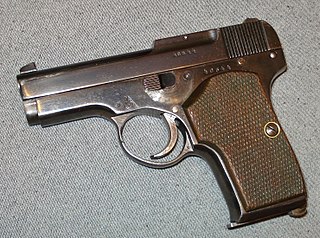
The Korovin pistol is regarded as the first Soviet semi-automatic pistol.

The SR-2 "Veresk" is a Russian submachine gun designed to fire the 9×21mm Gyurza pistol cartridge.
5.45×18mm MPTs (7N7) is a Soviet pistol cartridge. It is chambered in the PSM pistol, OTs-23 Drotik machine pistol, and OTs-26 pistol.
The OTs-23 Drotik is a blow-back operated machine pistol developed and used in Russia. The gun is also known as SBZ from the initials of its designers — I. Stechkin, A.V. Baltser, and A.V. Zinchenko

In firearms, a safety or safety catch is a mechanism used to help prevent the accidental discharge of a firearm, helping to ensure safer handling.

The New Nambu M57 (ニューナンブM57) is a series of semi-automatic pistols designed by Shin-Chuō Industries, later merged with Minebea. "New Nambu" was named after Kijirō Nambu, a notable firearm designer and the founder of Shin-Chuō Industries.
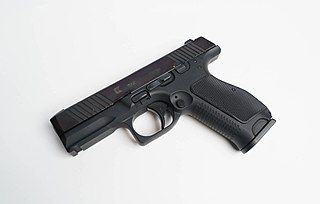
The Lebedev pistol is a Russian semi-automatic pistol, produced under Kalashnikov Concern and designed by Dmitry Lebedev. It was introduced in 2015 as the PL-14 and was redesignated to the PL-15 in 2016, with a compact version, the PL-15K, introduced in 2017.
